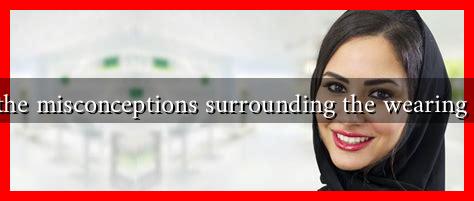-
Table of Contents
- What are the Misconceptions Surrounding the Wearing of a Hijab?
- Understanding the Hijab: A Cultural and Religious Symbol
- Misconception 1: The Hijab is a Symbol of Oppression
- Misconception 2: All Muslim Women Wear the Hijab
- Misconception 3: The Hijab is a Sign of Extremism
- Case Studies: Voices of Hijab-Wearing Women
- Conclusion: Embracing Diversity and Understanding
What are the Misconceptions Surrounding the Wearing of a Hijab?
The hijab, a traditional headscarf worn by many Muslim women, has become a symbol of both faith and controversy in contemporary society. While it is a deeply personal choice for many, misconceptions surrounding its significance and implications abound. This article aims to clarify these misconceptions, providing insights into the cultural, religious, and social dimensions of wearing a hijab.
Understanding the Hijab: A Cultural and Religious Symbol
The hijab is often misunderstood as merely a piece of clothing. However, it carries profound cultural and religious significance. For many Muslim women, wearing a hijab is an expression of their faith and identity. It is important to recognize that the hijab is not a monolithic concept; its meaning can vary widely among individuals and communities.
Misconception 1: The Hijab is a Symbol of Oppression
One of the most pervasive misconceptions is that the hijab symbolizes oppression and lack of freedom. This view often stems from a Western perspective that equates the hijab with forced subjugation. However, many women choose to wear the hijab voluntarily as an expression of their faith and personal autonomy.
- According to a 2017 study by the Pew Research Center, 62% of Muslim women in the U.S. reported that they wear the hijab by choice.
- Many women express that wearing the hijab empowers them, allowing them to be judged by their character rather than their appearance.
Misconception 2: All Muslim Women Wear the Hijab
Another common misconception is that all Muslim women are required to wear the hijab. In reality, the decision to wear a hijab is highly personal and varies based on individual beliefs, cultural backgrounds, and interpretations of Islamic teachings.
- Some Muslim women choose to wear the hijab as a sign of modesty, while others may opt for different forms of dress.
- In some cultures, the hijab is not a common practice, and women may express their faith in other ways.
Misconception 3: The Hijab is a Sign of Extremism
There is a prevalent stereotype that associates the hijab with extremism or radicalism. This misconception is fueled by media portrayals that often link Muslim women who wear hijabs to terrorism or fundamentalism. In reality, the vast majority of hijab-wearing women are peaceful and contribute positively to their communities.
- A 2018 report by the Institute for Social Policy and Understanding found that Muslim Americans are among the most engaged and civic-minded groups in the U.S.
- Many hijab-wearing women are active in various fields, including education, healthcare, and politics, challenging the stereotype of extremism.
Case Studies: Voices of Hijab-Wearing Women
To further illustrate the diversity of experiences among hijab-wearing women, consider the following case studies:
- Yasmin Seweid: A New York college student who was attacked for wearing a hijab, Yasmin became an advocate for Muslim women’s rights, emphasizing that her hijab is a source of strength.
- Ilhan Omar: The first Somali-American elected to the U.S. Congress, Omar has spoken about her hijab as a symbol of her identity and resilience, challenging misconceptions through her political work.
Conclusion: Embracing Diversity and Understanding
Misconceptions surrounding the hijab often stem from a lack of understanding and exposure to diverse perspectives. It is crucial to recognize that wearing a hijab is a personal choice that can signify empowerment, identity, and faith for many women. By challenging stereotypes and fostering open dialogue, society can move towards a more inclusive understanding of cultural and religious practices.
In summary, the hijab is not merely a piece of clothing; it is a complex symbol that varies in meaning among individuals. By addressing these misconceptions, we can promote a more nuanced understanding of the hijab and the women who choose to wear it. For further reading on this topic, consider exploring resources from organizations like the Institute for Social Policy and Understanding.

